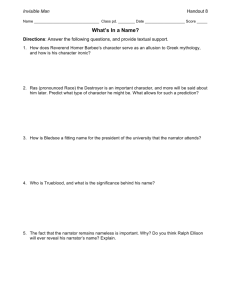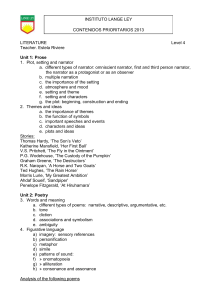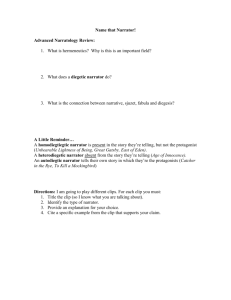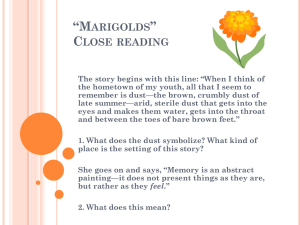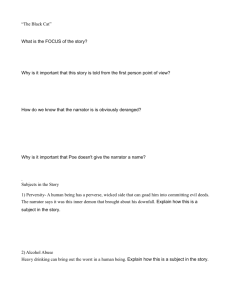When I teach Raymond Carver's “Cathedral,”
advertisement
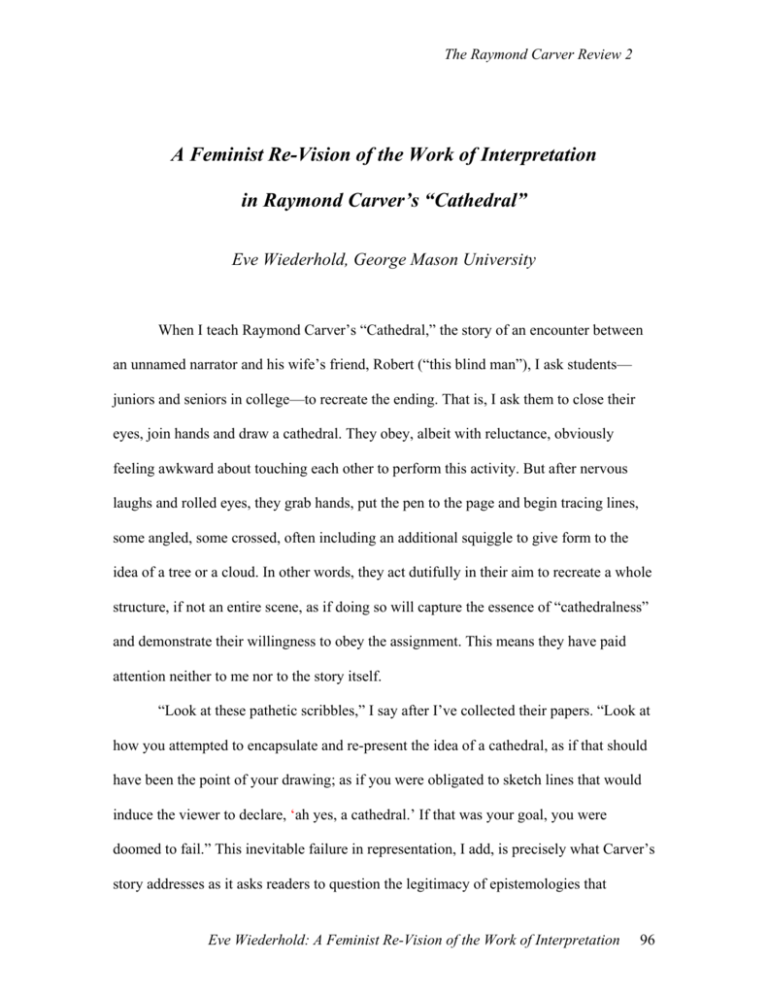
The Raymond Carver Review 2 A Feminist Re-Vision of the Work of Interpretation in Raymond Carver’s “Cathedral” Eve Wiederhold, George Mason University When I teach Raymond Carver’s “Cathedral,” the story of an encounter between an unnamed narrator and his wife’s friend, Robert (“this blind man”), I ask students— juniors and seniors in college—to recreate the ending. That is, I ask them to close their eyes, join hands and draw a cathedral. They obey, albeit with reluctance, obviously feeling awkward about touching each other to perform this activity. But after nervous laughs and rolled eyes, they grab hands, put the pen to the page and begin tracing lines, some angled, some crossed, often including an additional squiggle to give form to the idea of a tree or a cloud. In other words, they act dutifully in their aim to recreate a whole structure, if not an entire scene, as if doing so will capture the essence of “cathedralness” and demonstrate their willingness to obey the assignment. This means they have paid attention neither to me nor to the story itself. “Look at these pathetic scribbles,” I say after I’ve collected their papers. “Look at how you attempted to encapsulate and re-present the idea of a cathedral, as if that should have been the point of your drawing; as if you were obligated to sketch lines that would induce the viewer to declare, ‘ah yes, a cathedral.’ If that was your goal, you were doomed to fail.” This inevitable failure in representation, I add, is precisely what Carver’s story addresses as it asks readers to question the legitimacy of epistemologies that Eve Wiederhold: A Feminist Re-Vision of the Work of Interpretation 96 The Raymond Carver Review 2 precede our interpretive acts and guide what we think we should do with symbols. When we fail to question those epistemologies and their effects on our interpretive practices, we can make some inane decisions about how to understand and partake in our representational work. Because Carver’s story offers this lesson, it is germane to a feminist review. More specifically, “Cathedral” can be read to help articulate the elements of a feminist materialist rhetoric that questions the metaphysical goal of using symbols to generate the reappearance of an originary self-presence and to regard the endeavor as virtuous. This goal marks the difference between philosophy and rhetoric, and contemplating that difference can enable us to craft other organizing frameworks to guide conceptions of interpretive processes. That students are so obedient in their endeavors to draw accurately may tell us something about how they have learned to signify that they are “in the know.” Their responses indicate that a cultural regard endures for a component part of Western philosophy that can be found in texts as diverse as Platonic dialogues and eighteenthcentury aesthetics. This tradition would civilize language by imposing order on conceptions of its production and reception. It is committed to the pursuit of truth that, presumably, is accessible to receptive audiences because it will be recognizable once it is found. By showing devotion to “cathedralness,” the students offer a “modern incarnation” 1 of this history, demonstrating that they have adopted the expectation that one should bring order and completeness to any representational task at hand. Such expectations are cultivated by the idea that the goal of representation is to encapsulate an already-available truth that is absolute, repeatable, and translatable. Eve Wiederhold: A Feminist Re-Vision of the Work of Interpretation 97 The Raymond Carver Review 2 Feminist theorists and scholars in rhetoric each have explored the limits of such expectations and their effects on conceptions of how knowledge is produced and recognized. Susan Miller, for example, has taken issue with the legacy of the Platonic idea that knowledge is an object made available for review, either empirically or through insight. She questions whether that review must occur in a context that allows for the neutral and objective contemplation of pure form. And by questioning the methods of review, she also questions the presumed goal of the work of representation: To tell the truth; to act as a testimonial to a kind of telling that is universally and eternally valid; to use writing to obtain a representational “fix.” Like Miller, Sharon Crowley explores an anti-rhetorical strain within Platonic-influenced epistemologies by tracing the impact of Western philosophies that have envisioned the isolated contemplation of pure form as the height of integrity. Crowley outlines the consequences of this vision: The general is given priority over the specific; the abstract is prioritized over the phenomenal “real”; the intellectual and rational take precedence over the embodied and the emotional. These explorations are pertinent to Carver’s story in that they highlight the ways in which Platonic thinking continues to influence conceptions of how people participate with language. In effect, “good” contemplation is obtained when the subject provides evidence of the attempt to grasp “the truth” and genuinely communicate it. To proffer that evidence, the language user is encouraged to mimic the model that prioritizes abstractions—to use language to re-present that which has been made available from judicious insight, that which is always true, that which expresses the big transcendent, coherent idea. Participation is measured and evaluated accordingly: how accurate, how judicious, how authentic, how representative of the mind of the genius, all of which, Eve Wiederhold: A Feminist Re-Vision of the Work of Interpretation 98 The Raymond Carver Review 2 presumably, will be recognizable to other like-minded geniuses (or, as in the case of students, geniuses-in-training). As the language of recognition suggests, a metaphor of vision organizes such descriptors of the work of interpretation. 2 Significantly, the visual act is itself rendered abstractly, as if removed from the realm of the personal, the touch of flesh, the sexually generated, the wandering gaze, and the rhetorical, each of which has been assigned to the domain of the feminine. Carver’s story about the interpretive interactions between a man who has physical vision and one who does not can be read to confound the logic that conflates metaphorical vision with knowledge. “Cathedral” not only calls attention to the role of physicality in the work of interpretation, it also disavows the idea that such work can itself be represented within narratives that aim to describe and then sum up complex moments of thought and action, memory and history, embodiment and cognition. Raising questions about how to conceive of representational acts speaks to the interpretive problems dramatized in “Cathedral” while giving shape to an alternative model of discursive participation informed by feminist rhetoric. Knowing Foundations Carver may be a genius but the narrator of “Cathedral” does not appear to be. Indeed for many readers, the narrator is something of a jerk. “Cathedral” tells the story of an interpretive encounter between Robert and the narrator, who does not give himself a name but announces a temperament by communicating a less than gracious attitude about Robert’s visit. The plot seems relatively simple: Robert, a former employer of and old Eve Wiederhold: A Feminist Re-Vision of the Work of Interpretation 99 The Raymond Carver Review 2 friend to the narrator’s wife (also unnamed), is paying a visit and the narrator, a misanthropic man of prejudice, is reluctant to play host. His wife worked for him one summer in Seattle ten years ago. She and the blind man had kept in touch. They made tapes and mailed them back and forth. I wasn’t enthusiastic about his visit. He was no one I knew. And his being blind bothered me. My idea of blindness came from the movies. In the movies the blind moved slowly and never laughed. ... A blind man in my house was not something I looked forward to. (209. The narrator’s “informed” perspective about “the blind” simultaneously conveys his ignorance and sets up the story’s dramatic tension, which appears to be resolved when knowledge is exchanged at the story’s end. At that point, Robert and the narrator join hands to draw a cathedral and satisfy Robert’s curiosity about what exactly a cathedral is. By engaging in this endeavor, the narrator appears to undergo an internal transformation as he realizes the limitations of his outlook. In sum, “Cathedral” tells a story about insight and personal change. At least this is the way the plot is conventionally told, particularly by my students who, when asked to write about the significance of the end, say something like: “The narrator, a man of many prejudices, learns a lesson from Robert and comes to see that it was he (the narrator) who has been blind.” This tidy conclusion is precisely what Carver’s story complicates. Rather than allow for definitive claims about the story’s meaning or characters, the narrator’s perspective in the opening paragraph can be read as a provocation, designed to cause the reader discomfort and in so doing, both dramatize and engender a decidedly disorderly encounter with the act of interpretation itself. By introducing representations that Eve Wiederhold: A Feminist Re-Vision of the Work of Interpretation 100 The Raymond Carver Review 2 generate uneasiness, “Cathedral” asks readers to question those rituals of reading that have lost their status as ritual and seem instead to be natural, inevitable, indeed logical. The narrator’s confession in “Cathedral’s” opening challenges the reader to consider how the narrator is rendering judgments and in so doing, asks the reader to look more closely at his or her own response patterns, particularly when encountering loaded phrases such as “this blind man.” On the one hand, most of us would denounce someone who objects to playing host to a person who is visually impaired. On the other hand, the narrator poses an important question about the influence that entrenched cultural narratives have on judgments about people and events. As rhetoricians argue, what we know is shaped by the contexts we inhabit and for those who have not had personal experiences with someone who does not have vision, knowledge of what that means does come through artifacts in popular culture such as films, most of which fail to depict stories about bodies that are not deemed to be “normal. ”The blind” occupy a generic place of “the handicapped” in U.S. culture, rarely seen, and when represented, typically identified in terms of lacking vision, as if the totality of an identity can be summarized with a single descriptor. The narrator’s blunt confession of displeasure holds up a mirror to the reader’s own attitudes about “the blind” and the ways in which the reader interacts with cultural signifiers that influence how bodies and identities are read. Students tend to bypass this kind of analysis when devising statements aimed to prove that they get the story’s point, having learned to rely instead upon reading conventions to compose their replies, including the convention that directs readers to find a way to resolve textual tensions. 3 In response to the narrator’s initial disclosures, Eve Wiederhold: A Feminist Re-Vision of the Work of Interpretation 101 The Raymond Carver Review 2 students tend to engineer judgments that dismiss his concerns by asserting a series of decorous obligations: He should not feel apprehensive about Robert’s visit. He should not fear the blind. He should be friendly to his wife’s friend. With these preconceived ideas in place, it becomes possible to validate the rightness and goodness of the idea of having such obligations by reading the ending as proof of their merit. This argument effectively suggests that the narrator does become that decorous person readers thought he should be. But in order to describe “Cathedral” as a story about the narrator’s transformation from cynical and misanthropic to open-minded and sociable, a corresponding view of Robert must be imposed. His character will be read as a heroic figure—the wise man who quietly imparts a valuable lesson to the skeptical and narrow-minded. In this version of the story, Robert’s lack of vision seems to endow him with special knowledge that enables him to “see beyond mere appearances” and, like the Platonic philosopher, offer enlightenment to those who mistook illusions for truth. Such an ascription is evident in student responses to the narrator’s description of his wife’s relationship with Robert, which was solidified on her final day at work: “On her last day in the office, the blind man asked if he could touch her face. She agreed to this. She told me he touched his fingers to every part of her face, her nose—even her neck! She never forgot it. She even tried to write a poem about it” (210). This activity, which the wife engaged in once or twice a year “usually after something really important had happened to her,” leaves the narrator unimpressed. “I didn’t think much of the poem. Of course, I didn’t tell her this. Maybe I just don’t understand poetry. I admit it’s not the first thing I reach for when I pick up something to read” (210). Eve Wiederhold: A Feminist Re-Vision of the Work of Interpretation 102 The Raymond Carver Review 2 Students tend to see in this passage more evidence of the narrator’s general obtuseness. Not only is he incapable of appreciating his wife’s attempts at selfexpression, he shows disrespect for and insensitivity to her emotional landscape, while his alarm at her physical contact with Robert is indicative of sheer pettiness. We discuss expectations that organize our experiences of marriage/cohabitation, and then I press them: Is he completely ridiculous to feel threatened by the physical exchange? Yes, they reply. There is nothing illicit. That’s how “the blind” communicate. What becomes clear is that, like the narrator, most students read “the blind man” in terms of cultural scripts that abstract and marginalize those assigned generic identity categories. Robert is typecast as the “blind man who has true wisdom,” the image of which has been offered in films, and the result is that this story of intimacy—a story so powerful it inspired the wife to write a poem—is converted into a tale of decency and purity about an embodied act of translation and interpretation. But to convert Robert into the wholesome hero means, according to the logic within such scripts, that the reader must deny the possibility that Robert’s desire to touch the wife’s face communicates erotic flirtation. To automatically desexualize “the blind man” is to see only part of his identity, to render him an idea rather than a person, and then to use that construction to evaluate the narrator’s response. One must believe that running one’s hand over another’s face is a neutral, information-gathering act and not charged with sexual energy, nor a transgression of physical boundaries of space that people, in the United States at least, are culturally conditioned to maintain. And of course, to illustrate what is at stake in this discussion, I invite students to run their hands across each other’s faces, an invitation they invariably refuse. Eve Wiederhold: A Feminist Re-Vision of the Work of Interpretation 103 The Raymond Carver Review 2 Why the refusal? Here, we encounter the limits of the philosophical frameworks that have shaped our understanding of what is included in and relevant to the work of interpretation. Rather than position Robert within prefabricated narratives about the wisdom of the blind and the narrator as his imperceptive opposite, we can read this story to undermine the authority of a dichotomous logic that would bring order and clarity by denigrating or sentimentalizing bodies engaged in interpretive encounters. What would happen, for example, if everyone mimicked the ways in which Robert reads another’s face? What would change about what is known and how we visualize states of knowledge? Valorizing the knowledge acquired through touch that is not necessarily translated into language disrupts the hegemony of current epistemologies that bear the legacy of the Platonic depiction of knowledge as an object available for review. Feminist Interventions Such disruptions have been launched by poststructuralist authors as various as Michel Foucault, Roland Barthes, and Jacque Derrida, each of whom has challenged prevailing epistemologies by examining the ways in which discursive practices bear upon acts of interpretation. Derrida, in particular, has made the point that signifiers do not present information; they communicate by acting within a linguistic system that establishes meaning through acts of deferral. The presence of meaning is always elusive and relational and involves an endless substitution of signifiers that come to be regarded as representative of truth itself. 4 Consequently, human knowledge can no longer be depicted as transcendent or visible to the potentially obtainable Discerning Eye. Repetition and difference, rather than language’s grip on truth, are fundamental to the Eve Wiederhold: A Feminist Re-Vision of the Work of Interpretation 104 The Raymond Carver Review 2 working of narrative, suggesting that language does not mirror but constructs what we know. Feminist theorists such as Teresa de Lauretis have argued that the emphasis in Derridean theory on linguistic “play” retains a masculinist bias by retaining the idea that the work of interpretation involves a neutral exchange of signs within an abstract discursive order. Such formulations do not consider how specific bodies contribute to how meaning is made. A materialist rhetorical approach builds upon Derridean analyses of language production by asking after the significance of the materiality of the sign when accounting for the experience of interpretation. Hence de Lauretis’s useful definition: “I use the term [experience] not in the individualist, idiosyncratic sense of something belonging to one and exclusively her own ... but rather in the general sense of a ‘process’ by which, for all social beings, subjectivity is constructed” (159). Because one’s reality is immersed in social domains, experience can be described as a perpetual dynamic of one’s subjective engagement in practices, discourses, and institutions that are “social and ... historical”(159). Wendy Hesford makes a similar point by noting that “the concept of ‘material rhetoric’ highlights the discursivity of the material world as well as the materiality of discourse” and in so doing “prompts consideration of how individual and collective struggles for agency are located at complex intersections of the discursive and material politics of everyday life” (197). Acknowledging a perpetual interplay between bodies and texts alters the context for envisioning the work of interpretation and invites more scrutiny of the ways in which we think bodies abide those enigmatic transactions. To acknowledge embodiment as a contributor to how we know requires a rereading of “the Eve Wiederhold: A Feminist Re-Vision of the Work of Interpretation 105 The Raymond Carver Review 2 body” and a disentangling of embodied readings from normative narratives that affect how individuals engage with cultural scripts. Such a review would encourage readers not only to seek something that might be described as knowledge of the experience of reading but also to interrogate the satisfaction they receive when they think they’ve figured everything out. One specific strategy for staging this kind of interrogation would explore the ways in which reading conventions propel judgments about what in a text holds significance. Significance is a provocative word because it both grounds acts of reading in general and remains evasive when we attempt to pin down its meaning in any particular case. As Patricia Harkin writes, finding the significance of a text is deemed to be basic to the act of reading itself. Indeed, we expect texts to have significance and if they don’t, we tend to question why we’ve bothered to engage in the reading act at all (67). This conventional view of significance, however, suggests that its qualities will be evident to those readers who know how to sort through narrative complexities and perceive what warrants attention. But it is within the domain of significance that competing perspectives may collide. Material bodies engaging with material texts will likely disagree about what matters—that is, about what deserves notice and further review. Hence, rather than ask readers simply to seek significance, the convention of significance can be explored to consider how meaning is assigned through our subjective interpretations of alreadywritten constructs that may subsequently condition our responses. Each incident described in Carver’s story is available for this kind of materialist review in which reading for significance means choosing what to see and not see in any given scene of representation. When reviewing the story’s opening, for example, how Eve Wiederhold: A Feminist Re-Vision of the Work of Interpretation 106 The Raymond Carver Review 2 should readers weigh the significance of the narrator’s brusque style, which mocks his wife for writing a poem about her experiences with Robert even as the narrator undertakes to do the same thing in prose? What should readers make of the narrator’s choices about what to develop and what to mention briefly as his story unfolds? For example, we learn in passing that the narrator’s wife, while married to a military officer, attempted suicide and that this act prompted her to contact Robert after she quit her job. Here, the narrator’s apparent lack of interest in talking about his wife’s suicide attempt would be of interest, particularly when exploring the text’s representation of gender. The relative invisibility of the wife’s perspective throughout the story supports a reading that suggests that Carver has followed the convention of using a female character as a material obstacle to overcome to enable a male protagonist’s intellectual epiphany. Students might be encouraged to mull over this observation by considering how the word “wife” has been positioned within the “histories of articulation” (Ahmed 1) that will influence ways in which the wife in “Cathedral” gets read. The cultural subordination of those who are assigned the identity category “wife” lends support to the idea that “Cathedral” is about the narrator’s transformation. The trauma of a suicide attempt and speculation about its relevance to the story can be credibly pushed aside, weighted as a mere detail like all of the other background information, and therefore rendered relatively insignificant when determining “Cathedral’s” overall significance. Interestingly, however, representations of Robert’s wife can be read to complicate examinations of gender’s representation at a moment when the narrator is at his most objectionable: when conveying his surprised reaction to the news that Robert married and that his wife’s name was Beulah. Eve Wiederhold: A Feminist Re-Vision of the Work of Interpretation 107 The Raymond Carver Review 2 “Beulah! That’s a name for a colored woman.” “Was his wife a Negro?” I asked. “Are you crazy?” my wife said. “Have you flipped or something … What’s wrong with you?” she said. “Are you drunk?” “I’m just asking, I said. (212-213) That Carver included this exchange in the story at all is problematical because it communicates an unspoken acceptance of a context that presumably informs the narrator’s question: that Caucasian identity stands as a neutral point of reference to which all other identities are compared, and then marked as different. And given previous evidence of the narrator’s cynicism, it seems reasonable to conclude that his “just asking” is a statement that also aims to exasperate and challenge, if not belittle. Yet the exchange about Beulah’s racial identity offers another site of dissonance that can prompt readers to consider how our allegiances to reading conventions guide interpretive habits. The narrator’s ostensibly offensive comments about Beulah can be read to ask readers to confront the network of codes that must be in place in order for a statement to be “recognized.” How have established networks of codes invisibly underwritten a referential system that gets regarded as real, and once so regarded, regulates what will get seen to enable an interpretation to be rendered? Such questions encourage readers to think about the ways in which judging what offends emerges contextually and not because one has recognized an unchanging essential quality. This is not meant to disregard the significance of the narrator’s snide attitude. But if “whiteness” were not positioned as a default center from which other races and ethnicities are read as marked, then a question about Beulah’s racial identity would not necessarily function as a Eve Wiederhold: A Feminist Re-Vision of the Work of Interpretation 108 The Raymond Carver Review 2 signifier of a racist boorishness. After all, why wouldn’t Robert, whose race is never described but apparently is Caucasian given the wife’s reaction, marry a woman of color? (Indeed, the narrator asks several questions that seem impertinent: To his wife: Should we take Robert bowling? To Robert: Where did you sit on the train? Do you want to watch TV? Such questions can be read as mocking Robert’s lack of vision. And yet these questions are also unexpected and interesting. How does a person who does not see decide where to locate his or her body in space? Is it possible to know how to throw a bowling ball down a lane by using sensory information other than vision? Further, it turns out that Robert owns two televisions, one of which broadcasts in color.) Because the narrator’s responses can be read simultaneously as callous and astute, they cannot be rendered meaningful via summary and organized classification. This becomes especially clear after he speculates on the state of Beulah and Robert’s marriage, offering another opportunity for exploring Carver’s representations of the interplay between what discursive orders present and what we are able to know: They’d married, lived and worked together, slept together—had sex, sure—and then the blind man had to bury her. All this without his having ever seen what the goddamned woman looked like. It was beyond my understanding. Hearing this, I felt sorry for the blind man for a little bit. And then I found myself thinking what a pitiful life this woman must have led. Imagine a woman who could never see herself as she was seen in the eyes of her loved one. ... A woman whose husband could never read the expression on her face, be it misery or something better. ... And then to slip off into death, the blind man’s hand on her hand, his blind eyes Eve Wiederhold: A Feminist Re-Vision of the Work of Interpretation 109 The Raymond Carver Review 2 streaming tears—I’m imagining now—her last thought maybe this: that he never even knew what she looked like, and she on an express to the grave. Robert was left with a small insurance policy and half of a twentypeso Mexican coin. The other half of the coin went into the box with her Pathetic. (213-14) There is a perpetual doubling in all of the narrator’s statements that, when given significance, can be used to offer alternative models for thinking about how we reach conclusions by interacting with signs put forth for review. What is visible in the offending paragraph: A derisive attitude revealed through a rhetorical style that is also strangely humorous; a rejection of sentimental romance narratives that also conveys faith in the power of love. And most crucially, even though the narrator’s response might be regarded as the height of tactless incivility, it also conveys a poignant sensitivity as he considers what the woman who has physical vision will not receive from a lover who cannot see. The absence of visual adoration as a non-verbal communication is not inconsequential, and to disregard it is to deny an important part of how people who have vision experience love. This is not to say that lack of vision precludes intimacy. Rather, the narrator’s comments can be read to refuse the binary logic that would construct vision and its lack as opposites. To dismiss the narrator’s perspective is to overlook our susceptibility to narratives that valorize the domain of cognition and intellect by denigrating that which is associated with the material, the phenomenal, and the embodied. Indeed, who knows what can be learned from the look of love? Rereading Conclusions Eve Wiederhold: A Feminist Re-Vision of the Work of Interpretation 110 The Raymond Carver Review 2 This insight offers a different position from which to read and assign significance to the story’s last scene, which can be read as a depiction of the failure of speech as much as the acquisition of insight. Without any frame of reference, that is, without any prior knowledge of context, Robert is unable to interpret the narrator’s words to comprehend what a structure called a cathedral looks like and how it would compare to other structures that are identified in other ways. At Robert’s request, they join hands to draw. And then the last paragraphs: So we kept on with it. His fingers rode my fingers as my hand went over the paper. It was like nothing else in my life up to now. Then he said, “I think that’s it. I think you got it,” he said. “Take a look. What do you think?” But I had my eyes closed. I thought I’d keep them that way for a little longer. I thought it was something I ought to do. “Well?” he said. “Are you looking?” My eyes were still closed. I was in my house. I knew that. But I didn’t feel like I was inside anything. “It’s really something,” I said. (228) The meaning of “It’s really something” is about as ambiguous as it gets, and the lack of clarity provides a space in which readers can encounter the cultural push to fold conceptions of interpretive transactions into a language of virtue in order to assign significance. A cultural investment in, for example, narratives of redemption encourages readers to see evidence of the narrator’s transformation, when one could just as easily question whether anything of the sort occurred. “I was in my house. I knew that. But I Eve Wiederhold: A Feminist Re-Vision of the Work of Interpretation 111 The Raymond Carver Review 2 didn’t feel like I was inside anything” could be read to signify confusion as much as selfawareness. By the time this statement is uttered, much alcohol has been consumed along with marijuana; it just might reflect the narrator’s drug haze, an activity that is vilified in U.S. culture rather than regarded as, say, providing entry into life-enhancing alternative states of mind. The conventional reading—the one proffered on the web by various sources aimed at students writing term papers to demonstrate they get the story’s point— deemphasizes the drug activity to make claims about the narrator’s internal progression towards goodness: “One man’s prejudice is overcome by another man’s gift”; “While Robert is physically blind, it is the narrator who cannot clearly see the world around him”; and “As the story progresses, the narrator’s eyes are opened to the blind man’s world.” 5 Such summations seem indicative of the reader’s good will, which may be one reason why students are so eager to offer them. After all, what could be more satisfying to a teacher than to know that her students have appreciated and learned from a story about another person’s growth? But to devise this version of the story’s meaning, readers must rely upon a commonplace that suggests that reciprocity characterizes the work of interpretation. Accordingly, one interlocutor can become like another; the other can be read like one’s self. Equitable interpretive transactions appear to be structured by a discursive order that continues to be regarded as an abstract and neutral vehicle that allows for fair and evenhanded substitutions. But in Carver’s story, there isn’t equity. Even after they share in the act of drawing, the narrator still has no idea of what it is like to be blind and Robert has no visual knowledge of the cathedral. To suggest as much is to enact an interpretive violence that favors the abstract summary over the particularity of Eve Wiederhold: A Feminist Re-Vision of the Work of Interpretation 112 The Raymond Carver Review 2 lived experience. This is not to say that nothing benevolent happened in their encounter. But expressing what happened is a completely different issue. What they experienced as they clasped hands and embarked on a shared embodied activity cannot be fully recuperated into a summary narrative that the rest of us will recognize and deem significant. Nor is it certain that a language exists that could convey what was specific to each of their experiences in this event. Instead of devising a tale that unquestionably reveals a transformation, Carver’s story leads us back to that old but still relevant question feminists posed decades ago: What is the relationship between language and experience? How are dominant languages inadequate for expressing the contours of interpretive experiences that emerge from various embodied reactions we have to vision, its lack, its relationship to touch, to the capacity of touch to change an attitude and persuade one to listen differently? To presume equity within a visual representational economy is to establish an interpretive framework for reading that not only overlooks what can be distinctive in each component part of our interpretive encounters, but also installs a preference for coherence, homogeneity, the familiar, the conventional, the cognitively recognizable, each of which appears to be automatically significant, valuable and authoritative. Alternatively, those representations that don’t exhibit such recognizable qualities tend to be discounted and then dismissed. But if context and embodiment affect how texts are read, then knowledge cannot be fully objectified and made available for review. Knowledge instead is determined rhetorically and involves a transaction between speakers and audiences that incorporates the ways in which each adheres to, challenges, or translates institutional norms that precede utterances and make them comprehensible. Eve Wiederhold: A Feminist Re-Vision of the Work of Interpretation 113 The Raymond Carver Review 2 And that transaction also implicates our judgments about which people will seem worth listening to. Carver’s story can be read to generate questions about the ethics and ambivalence of those interpretive practices that seem most familiar and proficient. The materialist feminist rhetorical response that I have sketched here proposes an alternative model for imagining how bodies interpret what has value as they interact with cultural texts that make something like communication possible. 1 Thanks to an anonymous reviewer of this essay for this phrase. I would like to thank both anonymous reviewers for their astute and helpful comments about how to strengthen my argument. 2 See Martin Jay as well as Peggy Phelan for explorations of the importance of visual metaphors within Western epistemologies. 3 Patricia Harkin’s Acts of Reading influences this part of my discussion. Her book introduces students to the idea that acts of reading are not natural, but organized by cultural conventions. 4 See Mary Poovey’s “Feminism and Deconstruction” for a helpful elaboration of this point. 5 These interpretations can be found at: www.associatedcontent.com/article/13368/blind_to_the_truth_blindness_in_raymond.ht ml and www.123helpme.com/search.asp?text=cathedral Eve Wiederhold: A Feminist Re-Vision of the Work of Interpretation 114 The Raymond Carver Review 2 Works Cited Ahmed, Sara. The Cultural Politics of Emotion. New York: Routledge, 2004. Crowley Sharon. Composition in the University. Pittsburgh: University of Pittsburgh Press, 1998. Carver, Raymond. Cathedral: Stories. New York: Vintage Contemporaries, 1989. De Lauretis, Teresa. Alice Doesn’t: Feminism, Semiotics, Cinema. Bloomington: Indiana University Press, 1984. Harkin, Patricia. Acts of Reading. New Jersey: Prentice Hall, 1999. Hesford, Wendy. “Reading Rape Stories: Material Rhetoric and the Trauma of Representation.” College English 62.2 (1999): 192-221. Jay, Martin. Downcast Eyes: The Denigration of Vision in Twentieth-Century French Thought. Berkeley: University of California Press, 1993. Miller, Susan. Textual Carnivals: The Politics of Composition. Carbondale: Southern Illinois University Press, 1991. Phelan, Peggy. UnMarked: the Politics of Performance. London: Routledge, 1993. Poovey, Mary. “Feminism and Deconstruction.” Feminist Studies 14.1 (1988): 51-65. Eve Wiederhold: A Feminist Re-Vision of the Work of Interpretation 115
